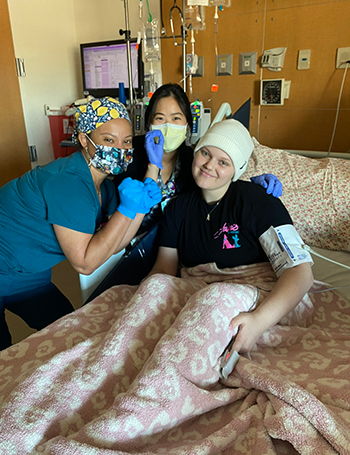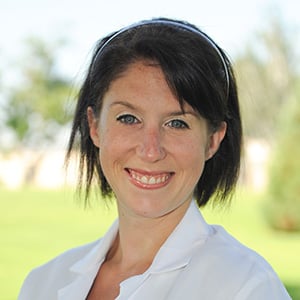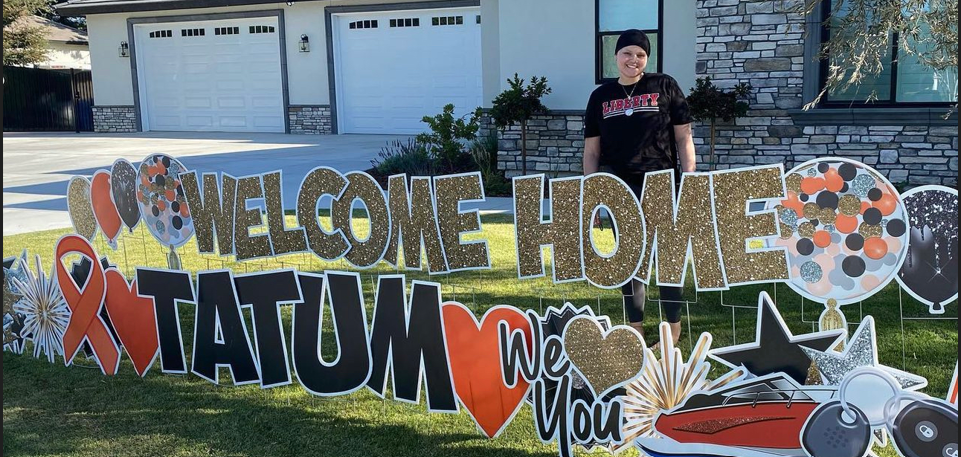Tatum Demontmorency loves volleyball. Growing up in Bakersfield, California, she’s played the sport since age 10, starring on her school teams and now, at 19, coaching the squad at her old high school.
A sophomore at Bakersfield College, Tatum has her eye on a career in health care, possibly as an ultrasound technician.
When not hitting the books or spiking the ball, Tatum works part time at Jake’s, a local Tex-Mex restaurant.
She and younger brother Trey are inseparable best buddies. Together with their parents (Naomi is a schoolteacher, Troy a general contractor), they are a strong, tight-knit family steeped in faith, supporting each other and doing the right thing.
Just over two years ago, Tatum and her family faced a crisis that tested all of them.
In early 2021, Tatum began to feel weak and fatigued, with unexplained back and neck pain. “Suddenly she was just not her happy self,” recalled Naomi. “We thought it might be stress.”
Multiple visits to urgent care failed to provide an answer. At first doctors suspected a viral infection like mononucleosis. They told Tatum to go home and rest. She did, spending a week sleeping and doing little else. She didn’t get better.
By early May, Tatum was also experiencing severe stomach pain, prompting her doctors to consider either gall bladder or appendix issues. Deep down though, Mom feared it was far worse.
“I called my husband,” she remembered, “and just started crying. ‘Something’s wrong with Tatum!’”
An Unthinkable Diagnosis

The pain kept getting stronger.
“I couldn’t stand up, couldn’t walk,” Tatum recalled.
Finally, their urgent care doctors did some bloodwork as well as a CT (computed tomography) scan of Tatum’s stomach. Now they had the answer.
“The doctor says to me, ‘Mom, you’d better sit down.’ That’s when I knew it was pretty bad,” Naomi said. “And then he said, ‘Tatum has leukemia.’”
That wasn’t all.
“They told us we needed to get to Los Angeles right away,” said Naomi, “so Tatum could begin treatment at a cancer facility. ‘There’s a bed waiting for her,’ they said.”
The shock of Tatum’s diagnosis, plus the “Go now!” order to pack up and leave home immediately, was more than they could take.
“I was devastated,” said Naomi. “You have this feeling, how could this happen to my child? You can’t fathom it. The pediatrician, Tatum and I were all crying and hugging each other.”
For Tatum, the crying gave way to anger.
“It took me a while to wrap my head around it,” she said. “Mostly I was irritated at having to go to LA.”
Even harder was the task of breaking the news to Trey, only 13 at the time. Naomi agonized over having to tell him that the family, including his sister, were all leaving. Trey would have to stay with relatives because his sister had cancer. “We packed our bags and left him,” Naomi said, emotion cracking her voice.
They would spend the next 40 days at the LA hospital, a stay Naomi described as “awful.” This was COVID-19 time. Trey wasn’t allowed to visit his sister. Mom, however, never left Tatum’s side.
An Aggressive Cancer
Doctors determined that Tatum had acute myeloid leukemia (AML), a rare and deadly form of the disease, although in children the survival rates are better than in adults, approaching 60%.
Complicating Tatum’s case was the fact that her AML was of the “mixed lineage” variety. Occurring predominantly in children, mixed-lineage leukemia (MLL) is especially aggressive and can be tougher to treat.
“MLL is a genetic rearrangement commonly found in pediatric leukemias,” explained pediatric hematologist-oncologist Nicole A. Karras, M.D., associate clinical professor in City of Hope's Children's Cancer Center. “It puts patients at higher risk.”

Her doctors laid out a plan to treat Tatum with five cycles of chemotherapy, each lasting 30 to 45 days. They were optimistic. Tatum did the mental math. If all went well, she’d be done by October and able to rejoin her high school classmates in time to finish her senior year and graduate. Not too bad, she thought.
The first two cycles went well. Tatum’s cancer stopped growing and she had minimal side effects. But starting with cycle three, things went south. She developed infections, mouth sores, nausea and more. “I was so miserable,” she remembered, “I thought this was never going to end.”
Cycle four was even worse, leaving Tatum quite ill and mentally exhausted. But the real heartbreaker was yet to come. A bone marrow biopsy taken before cycle five revealed that Tatum’s cancer had relapsed.
“I didn’t know how much more of this I could handle,” she said. “And now I knew I wouldn’t be back in school so soon.”
Unable to help her any further, her doctors now sent Tatum to City of Hope to attempt a stem cell transplant, her only remaining option. Immediately on arriving, the family sensed a different tone, starting with their first meeting with Karras.
“She’s so incredible,” said Naomi. “She’s upbeat. She laughs a lot. She knew everything about Tatum’s case, but she wasn’t all gloom and doom. She sent out a definite feeling of ‘We got this.’”
An Experimental Drug
There was still too much cancer in Tatum’s system to attempt a transplant. But it turns out, the Demontmorencys had come to City of Hope at the most opportune time. That’s because Karras was involved in a clinical trial of a targeted therapy drug specifically aimed at Tatum’s form of MLL. The drug disrupts the menin protein that is activated in MLL, which had made Tatum’s leukemia so dangerous. “Not many cancer centers have this treatment available for children,” said Karras, adding, “Without it, I’m not sure Tatum would be around today.”
The twice-a-day pills (which Tatum could take at home) did their job, keeping Tatum in remission. “The trial cleared out all the detectable cancer,” said Karras. She followed up with intense chemotherapy, standard procedure as the final preparation for transplant.
Karras informed the family that Trey would be Tatum’s stem cell donor. He was a 50% match, but younger than either parent, and no unrelated donor who was a closer match could be found. Trey’s reaction? “He said, ‘Yeah, I’m in!’” Naomi recalled. Nevertheless, Naomi worried that Trey might feel responsible or even guilty should the transplant fail. A City of Hope clinical social worker took him aside and explained that although he was certainly helping, “You are not responsible for your sister’s life.” It set his mind (and Naomi’s) at ease.
Knowing little about the transplant procedure, Tatum worried about going through it. “Transplant,” after all, sounds like major surgery. “But then I saw them bring in this bag — it looked just like an IV transfusion bag,” she recalled. Now she could relax.
Tatum Heads Home
The transplant took place in March 2022. It went smoothly. Tatum developed a bacterial infection, but did not get graft-versus-host disease. City of Hope's supportive care services staff helped her pass the days in the hospital. Her stay was brightened by Child Life Specialist Marisol Trujillo, M.S., CCLS, who got Tatum involved in the Beads of Courage program, in which patients collect colored beads for different hospital procedures they’ve had. “I loved her!” Tatum says.
“Tatum and her mother were always so welcoming and always had a smile on their faces,” said Trujillo. “They always had a positive outlook, which was contagious.”

Also pitching in was AYA (Adolescents and Young Adults) Program Coordinator Davis Wideman. “He was so fun! We got together with other patients, and he never treated us like sick kids,” Tatum recalled.
And it wasn’t long before Tatum was no longer a “sick kid.” Her transplant was successful, and now, more than a year later, she is no longer taking immunosuppressant drugs and looking forward to her once again healthy life.
Karras says Tatum’s case — especially the clinical trial — is a testament to the City of Hope formula. “I think we are very good at tailoring care for each individual patient,” she said.
The family is filled with gratitude, first to God, but also to everyone at City of Hope. Naomi recalled her struggles elsewhere, just trying to be heard. Everything changed “once I got with the right people. They’re brilliant. And they really do care,” she said.
“They are just amazing,” echoed Tatum.